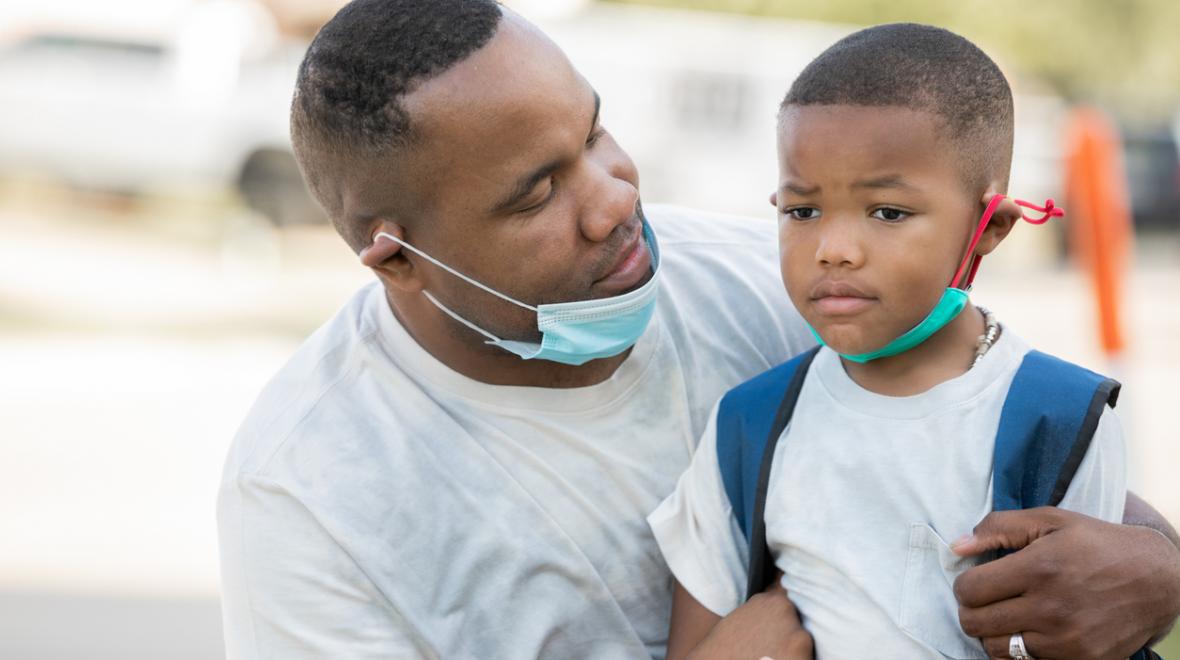
Whether you’re in the “I need school to start now!” camp or the “Summer just started!” camp, the fact is that the new school year is approaching quickly. Every year, back-to-school time is met with emotions ranging from excitement to nervousness or fear, but this year that’s even more true for students and families. Dr. Kendra Read, director of the Mood and Anxiety Program at Seattle Children’s, offers ways to reduce back-to-school worries as you support your child’s return to in-person learning.
“Uncertainty is often hard to tolerate, and times of transition in the midst of uncertainty are that much harder,” says Read.
This excerpted post was originally published on the Seattle Children's On the Pulse blog.
Here is some advice from Read to help navigate this trying transition:
Accept that all feelings are normal and valid.
Many children and youths will be excited about returning to school, reconnecting with friends and teachers, engaging in sports, clubs or performance arts, and feeling like things are going “back to normal.” Of course, excitement is often accompanied by jitters or nervousness.
Some kids will be afraid to leave the safety of home and go back to the social scene or behavioral norms and expectations that are part of a school day. They may feel anxious or worried about adjusting to a completely new schedule and routine.
Still others may be fearful about going back to their school with cases of COVID-19 still occurring around them, and news about the pandemic still a part of daily life.
Start talking with your child or teen to learn how they’re feeling about going back to school. There are no right or wrong answers. Help them name their feelings if they are having trouble doing so themselves, and let them feel the feelings they’re experiencing. It’s as simple as saying, “You’re feeling nervous,” if they share that feeling with you; or “It seems like you’re feeling angry,” if they’re having trouble naming their emotions. Truly hear them and try to understand their point of view, so they feel safe and validated.
Know that their feelings may change from day to day or when school gets underway. Continue to listen without judgment as they share what they’re thinking. This can help keep the lines of communication open, which is a very good thing! It is important to validate their feelings, even if you do not feel the same or agree with the behaviors linked to these feelings.
Get physically ready for the change in routine.
Start with getting back to healthy habits that promote physical and mental wellness. Reign in those late bedtimes a few weeks before school starts. Start moving bedtime 30 minutes earlier every three to five days until your child is getting the recommended amount of sleep for their age, based on when they’ll need to wake up on school days. Avoid screen time starting at least 30 minutes before bedtime.
Continue aiming to have your child move their body for at least 60 minutes each day. Being active reduces stress, improves sleep, and helps kids be ready to learn and cope with change and challenges.
Get any required immunizations, annual checkups or sports physicals scheduled now. Stay on top of preventive health visits, and schedule those appointments before life gets even busier.
Start planning to prepare healthy meals for school days. Enlist your child in making a list of fruits and vegetables they’d like to pack in their lunch or have ready for after-school snacks. Pick a water bottle they can take with them to help them stay hydrated. Make a schedule for sharing the responsibilities of school-night dinners — working side by side in the kitchen will be a great time to check in as the school year gets going.
Do you need to reinstate a family calendar, a backpack location or a homework station? Now’s a good time. Planning ahead will make the initial weeks less stressful.
Foster relationships that build resilience.
Nurturing relationships help build resilience by making kids and teens feel safe and secure. If you’re able to, set aside extra time to be available to your child or teen in the coming weeks. You don’t need to have an agenda for the time you spend with them. Being near provides opportunities for talking about hopes and fears, and also lets you say and demonstrate that you love your child. Consider visiting other loved ones in person or virtually to remind your child that they have extended family and friends who care for them.
If your school or community is offering back-to-school playground dates or events, try to attend them so you can make connections and build community. The feeling of “being in this together” can help boost your child’s confidence.
Prepare for bumpy patches by knowing ways to cope.
It’s likely that there will be some days that are tougher than others. Be ready for these times by planning ahead and helping your child see that they have the ability to deal with the emotions that may arise. Consider using a coping card to help your child think about what might be hard about school, how they’ll know if they’re having challenges, and what they can do to cope and feel better.
Use the coping card to work through feelings. This offers a healthy way to move forward, rather than avoiding school or other triggers that are making your child anxious. Know that the most helpful way to cope with anxious situations is to face them. Now is a good time to practice taking small steps toward facing fears that may arise once school starts. For example, you could have your child practice ordering in the drive-through if speaking in class might cause them anxiety.
At the beginning of the school year, teachers often send home parent questionnaires to obtain contact information and get helpful hints about their students. Take the time to offer any insights about how your child can be successful with learning and social issues that may arise at school. Learn how the teacher likes to communicate, should you have questions about your child’s mood, behavior or academic progress.
Know mental health warning signs and what to do in a crisis.
It’s normal for all kids to experience emotional ups and downs, but 1 in 5 kids will have a mental health problem that needs treatment. Mental health problems affect thinking, emotions and behavior. There are many warning signs of a problem, but some of the more common ones are feeling very sad or withdrawn for two or more weeks, severe mood swings, changes in eating or sleeping habits, or sudden, overwhelming fear for no reason. If your child is showing one or more of these signs, contact their doctor, and be specific about which behaviors you’re noticing. Visit our mental health resource hub, coping and COVID-19 page and the resources below for more help with supporting your child or teen’s mental wellness. Getting the right support will help your child improve their mental health.
Some things a child says or does can be a sign that they are in immediate danger. If your child or teen begins giving items they love away, talks about death, says goodbye to friends in person or on social media, engages in self-harm, stops doing things they love or says they feel like a burden, ask them directly if they are thinking about suicide. Asking does not increase the risk of suicide. Stay calm if they say they are thinking about suicide and:
- Call the National Suicide Prevention Lifeline for help: 1-800-273-8255.
- Reduce the risk of suicide by removing pills and firearms from your home. If you can’t remove them, place them in a safe, lockbox or other secure place.
- If they are in immediate danger of harming themselves, don’t leave them alone. Take your child to the closest hospital emergency department (ED). If you cannot safely transport your child, please call 911. Tell them you have a mental health emergency and need your child taken to the ED.
- You can also use your county crisis line for help with problem solving.
Reduce your family’s risk of getting COVID-19 and provide reassurance.
Help your child reduce any worries they may have about getting sick by continuing to follow prevention recommendations from your local health department and the Centers for Disease Control and Prevention. The best thing you can do is make sure everyone in your home who is eligible for the COVID-19 vaccine gets fully vaccinated. Stay on top of changing mask recommendations. As infection rates change and new variants circulate, mask guidance will change. Be alert for COVID-19 symptoms and know what to do if a family member exhibits symptoms.
Reassure your child by telling and showing them what your family, school and community are doing to stay well. Invite their questions and be honest when you don’t know the answer or when the answer changes as more is known about COVID-19.
If you’re noticing that your child is requesting repeated reassurance about health-related worries, check out our coping and COVID-19 resources for how best to respond. It isn’t helpful for parents to repeat reassurance when it gets in the way of children learning how to think through situations more independently.
Helping your child through difficult times means tolerating your own strong emotions. If you’re noticing that you’re experiencing your own anxiety, frustration, sadness or other emotion that is affecting your quality of life and your ability to follow these tips, seek your own support. All of the tips that we discuss here for youths apply to adults as well. Name and validate your feelings, face your fears and get help from a provider if you’re finding that it is hard to do on your own.
Give yourself, your child and others grace.
This past year and a half have been tough in so many ways. Sending your child back to school will be a big transition for all. Your child may have more anxiety than in years past, and you may feel more nervous sending them to school this fall. Teachers and school staff will be adjusting, too. Try to approach the year assuming everyone is doing their best. Practice self-care, support your child and get help if needed.
One resource for help is the Parent Trust for Washington Children Family Help Line, a toll-free number from anywhere in Washington state, available to parents, caregivers and anyone who has an interest or questions about a child in their community. Call to connect with parent coaches for supportive listening, parenting information, stress reduction tips and resources.
Give praise and celebrate wins, big and small!
Give specific praise for behaviors that you want to see more of, such as, “You were patient when we had to wait to talk to your teacher today,” or “You were brave and tried out for the team even though you’ve never played soccer before.”
Positive reinforcement can fuel more of the behaviors that you want to see.
As you practice, spotlight brave actions. Notice and celebrate the things that go well as your child embarks on the new school year. Celebrate your hard work as a caregiver, too! A smooth drop-off, great effort on an assignment or making first chair in band are all worthy of cheer!
“In the end, remember that it is okay, even expected, for you and your child to feel anxious, especially at times like this,” says Read. “Remember that anxiety will not hurt you and that the most helpful thing to do is stay in the moment, use mindfulness, ride the wave and celebrate those successes.”











